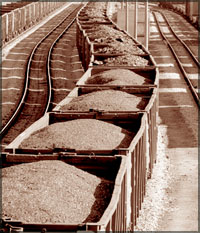|
 Coal,
the dominant (leading) fuel for electric power, faces an uncertain
future amid growing concerns about global warming and a race for new
ways to curb (cut down) emissions. Coal,
the dominant (leading) fuel for electric power, faces an uncertain
future amid growing concerns about global warming and a race for new
ways to curb (cut down) emissions.
Some experts say coal can still play an important role with new
technology being developed to capture and store carbon dioxide emissions
underground.
But environmental activists, who have long seen coal as the biggest
culprit in global warming emissions, cite an urgent need for incentives
to reduce greenhouse gases from power plants.
A study released by the Massachusetts Institute of Technology (MIT),
USA concluded that coal can remain an
|

Coal is the biggest culprit in global warming emissions.
|
attractive option from an environmental and economic standpoint
if the right steps are taken.
The key, the study concluded, is to move forward with technology to
'sequester' or capture and store carbon dioxide (CO2) gases, blamed for
global warming.
There are no technical obstacles to sequestration of CO2 in
geological formations, but this has not yet been used on a scale large
enough to get commercial support, the study authors said, and no
regulatory framework exists.
The report said power plant operators will only have an incentive to
use the new technology if there is a tax or cap on carbon emissions.
"What is needed is to demonstrate an integrated (combined) system of
capture, transportation, and storage of CO2, at scale," the report said.
In the meantime, coal is a front-burner issue with energy needs
increasing worldwide even as concerns about global warming are on the
rise.
In China, an average of one new coal-burning power plant is being
started up each week, with little attention paid to emission controls.
Coal provides 80 per cent of China's electricity and two third of its
energy needs. And fast-growing India depends on coal for 70 per cent of
its electricity.
In the United States, which produces half its electric power from
coal, utilities have tentative (not definite) plans for over 150 new
coal-fired plants by 2030, even though Congress is mulling (considering)
ways to curb greenhouse emissions.
"The worst thing we could do in terms of global warming would be to
build more coal-fired power plants," said Josh Dorner of the Sierra
Club, who said most of the plants would use "the oldest and dirtiest
technologies."
The MIT scientists said new coal plants that meet strict criteria for
capturing greenhouse gases would likely have to be built from scratch.
This suggests the use of new 'clean-coal' technologies, that also
remove conventional pollutants such as sulfur and nitrogen oxides. Some
call for 'gasification' or converting the coal to a gas before burning,
or using air-blown 'pulverised' (powdered) coal.
Ernest Moniz, an MIT professor and co-author of the study, said these
new technologies including carbon capturing could add about 50 per cent
to the wholesale cost of electric power and about 25 per cent to the
retail cost.
With those added costs, 'it's a kind of a horse race' with other
sources of power in terms of the price of electricity from coal, he
said.
Luke Popovich, spokesman for the National Mining Association,
acknowledged 'a confluence (mixture) of several events that appear to
have clouded coal's future'.
But he said coal is still preferable to alternatives for power
generation - more expensive natural gas, oil imports from unstable
regions and ever-controversial nuclear energy.
"There is an almost inexorable (not weakening) demand for electricity
that no reasonable expectation of conservation practices can
diminish(lessen)," Popovich said.
Seirra Club's Dorner admits coal will not disappear overnight, but
argued against increasing its use.
"Clean coal doesn't really exist," he said, because of the impact
from both mining and combustion (burning).
As for carbon storage, he said, "We don't have any idea whether or
when this will be possible."
Dorner said California has set a positive example by becoming more
energy efficient. By also using renewable (ability to be used again)
sources and "managing things better on the demand side, we won't need
all these coal plants tomorrow," he said.
City Times |
